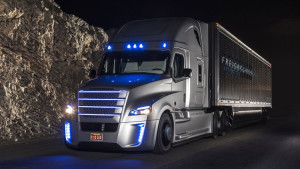In the trucking industry there is a lot of consternation on the part of truck drivers, particularly when it comes to the future. The recent unveiling of a so-called automated truck has many drivers on edge, fearing that the future will bring fleets of driverless trucks, allowing the shipping industry to operate their vehicles without employing drivers to control them.

Freightliner “Inspiration” autonomous truck
Rest assured, drivers are still very much a part of the future of the industry, and “driverless” is a bit of a misnomer. These trucks have what is essentially a cruise control that allows a driver to do other things during certain periods of the daily journey. In other words, there is no danger of real, live drivers going away any time soon.
So truck drivers are very much part of the future of the industry. In fact, the driver shortage is arguably the greatest source of stress for those who are banking on the future of the trucking industry, namely owners. There are of course new environmental regulations that will be expensive in the short term (though the regulations, and the breaks that are coming along with it, are designed to help companies make that money back), but still it’s sheer manpower that will make or break the next decade-plus for most companies.
That means you as a potential driver have great power, and have the opportunity not only to secure employment opportunity for yourself for the next decade and beyond, but a chance to really cement your career.
The key to that transition? Adaptation.
Many truck drivers want to focus on driving—that is, their job—and feel like messing with what they consider to be side concerns a waste of time. While those people will have jobs today and tomorrow, they are shortchanging their futures. By keeping up with the changes in the industry—including those technological changes—they would be securing their futures, and keeping themselves relevant in the industry.
Instead, those people will find themselves struggling to keep up with those changes once they arrive, and may be far behind the curve once they do arrive. That reality becomes frustrating for those people, and may even lead to them leaving the industry because of their inability to adapt to its demands.
But as a young driver, you will have the opportunity to thrive in this environment and take the lead in the next 10 years. The key to success is twofold: first, keeping up with what changes are coming, which means listening, looking, and reading up on a regular basis. Reading trucking blogs and news sites, speaking with management at your company and at others, and participating in things like union activities (if you are union), or trucking organizations, can help keep you in the know on what is coming, and when.r
The other key is something you can imminently control: your own attitude. No matter what industry you are in, chances are you are a small fish in a very big pond. That is never truer than for truck drivers, who are one of about 2.5 million. That’s a lot of opportunity for innovation and change, and as a single individual there is little you can do to control or stem the tides of change.
Instead, focus on going with the flow, so to speak. Be able to roll with the changes, and be as prepared as you can to see those changes coming. Worry more about what you have to learn than what you have already learned, and focus on the next task each day.
Change is happening in the trucking industry. It just is, and it’s happening whether you’re a part of it or not. Accepting that, and focusing instead on the changes that are to come, will keep you in the industry longer than swimming against the current and fighting the inevitable.

